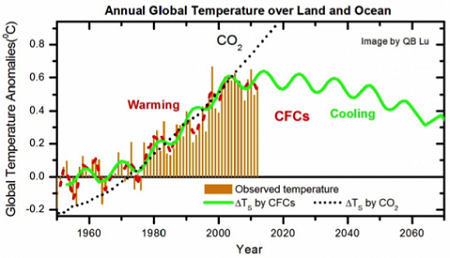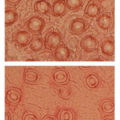
Conventional thinking on climate change holds that human emissions of carbon dioxide have been the major contributor to global warming, but an intriguing new study that examined data going back to the Industrial Revolution indicates that chlorofluorocarbons (CFCs) conspiring with cosmic rays are the real culprit. The research, by Professor Qing-Bin Lu at the University of Waterloo (Canada), appears in the International Journal of Modern Physics B.
“Most [climate change] theories expect that global temperatures will continue to increase as CO2 levels continue to rise, as they have done since 1850. What’s striking is that since 2002, global temperatures have actually declined – matching a decline in CFCs in the atmosphere,” Professor Lu said. “My calculations of CFC greenhouse effect show that there was global warming by about 0.6 & #176;C from 1950 to 2002, but the Earth has actually cooled since 2002. The cooling trend is set to continue for the next 50-70 years as the amount of CFCs in the atmosphere continues to decline.”
Central to the controversial new projection of lower global temperatures is Professor Lu’s cosmic-ray-driven electron-reaction (CRE) theory of ozone depletion. “It was generally accepted for more than two decades that the Earth’s ozone layer was depleted by the Sun’s ultraviolet light-induced destruction of CFCs in the atmosphere,” he explained. “But in contrast, CRE theory says cosmic rays play the dominant role in breaking down ozone-depleting molecules and then ozone.”
Lu’s theory is strengthened by observations of cosmic ray, CFC, ozone, and stratospheric temperature data over several 11-year solar cycles. “CRE is the only theory that provides us with an excellent reproduction of 11-year cyclic variations of both polar ozone loss and stratospheric cooling,” said Professor Lu. “After removing the natural cosmic-ray effect, my new paper shows a pronounced recovery by 20 percent of the Antarctic ozone hole, consistent with the decline of CFCs in the polar stratosphere.”
Impressively, by linking CFCs, ozone depletion, and temperature changes in the Antarctic, Professor Lu has been able to draw an almost perfect correlation between rising global surface temperatures and CFCs in the atmosphere. “The climate in the Antarctic stratosphere has been completely controlled by CFCs and cosmic rays, with no CO2impact,” he notes. “The change in global surface temperature after the removal of the solar effect has shown zero correlation with CO2 but a nearly perfect linear correlation with CFCs – a correlation coefficient as high as 0.97.”

Lu’s analysis indicates that the “Montreal Protocol on Substances that Deplete the Ozone Layer” may actually play a pivotal role in lowering global temperatures. “We’ve known for some time that CFCs have a really damaging effect on our atmosphere and we’ve taken measures to reduce their emissions,” Professor Lu said. “International efforts such as the Montreal Protocol have also had a profound effect on global warming.”
The paper also predicts that the global sea level will continue to rise for some years as the hole in the ozone gradually recovers. “Only when the effect of the global temperature recovery dominates over that of the polar ozone hole recovery, will both temperature and polar ice melting drop concurrently,” Lu concludes.
Related:
Discuss this article in our forum
Arctic ice shrinks, Antarctic grows
Sea-level rise predictions may be missing critical factors
Greening of Arctic will be dramatic, say scientists
Volcanoes keeping a lid on global warming


















Comments are closed.